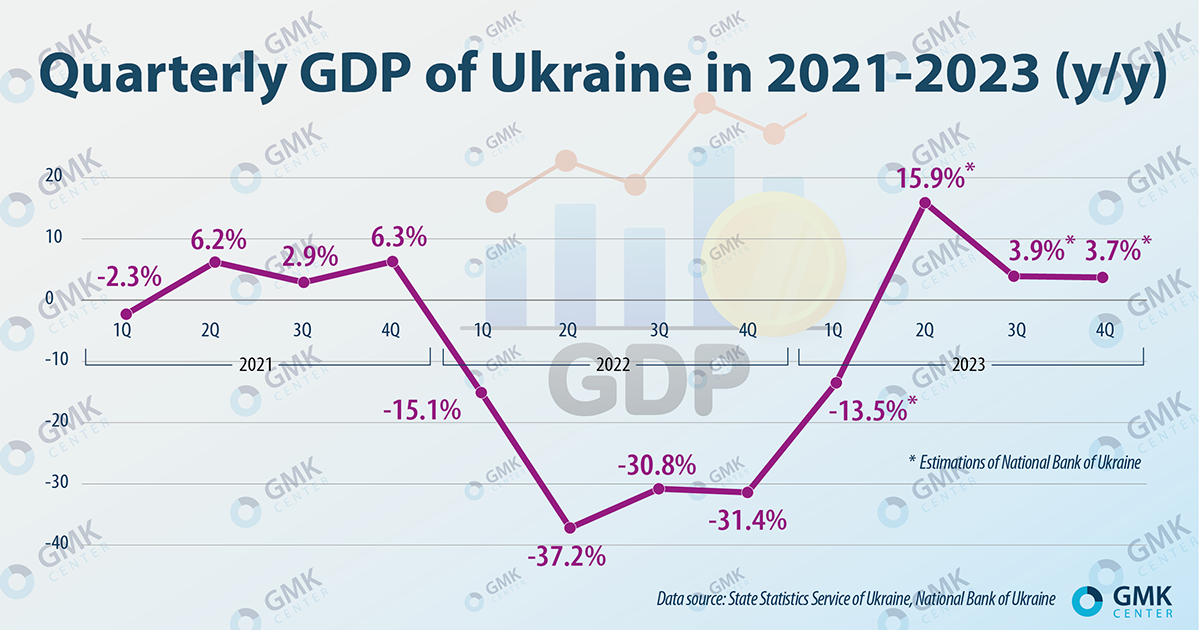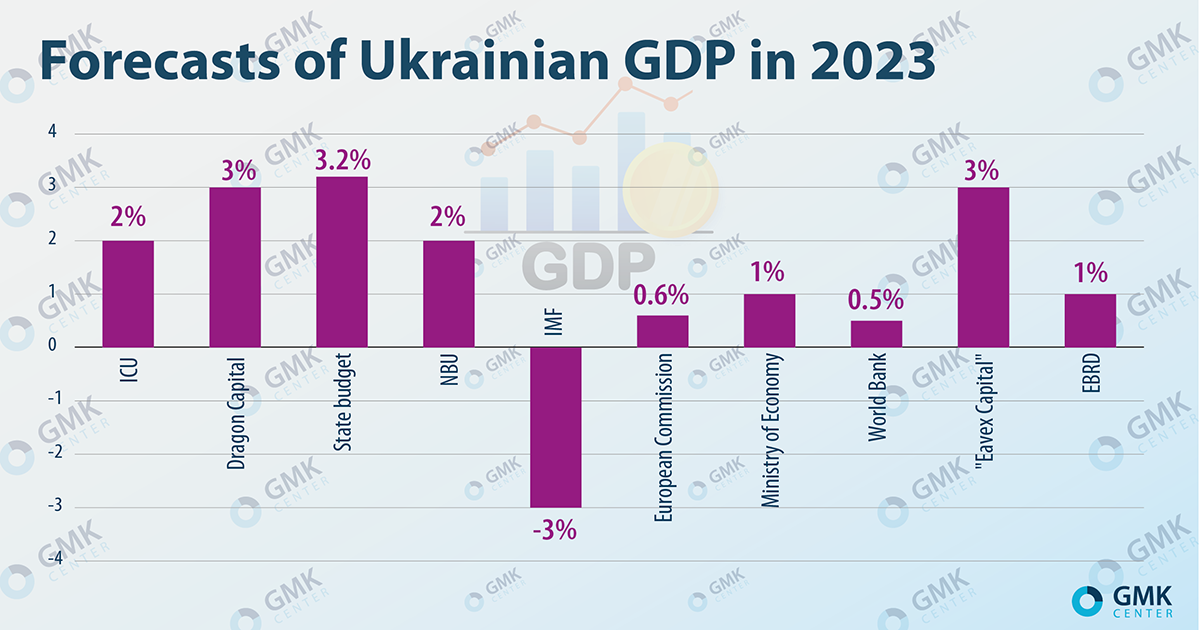Doing business

The situation in the Ukrainian economy fluctuates and is influenced by many force majeure factors due to hostilities. Under such conditions, the planning horizon for a business is at best a month, and forecasts and expectations for a year are more like guessing on coffee grounds. But, as practice shows, the adjusted forecasts made in the first half of the year are very close to the result of the end of the year.
According to the NBU, despite the continuation of the negative trends in the first quarter (-13.5%), the Ukrainian economy will experience a significant rebound in the second quarter – an increase of 15.9% at once. This is possible due to the low comparative base of the same period last year (-15.1% y/y). In the third and fourth quarters of 2023, the National Bank expects growth to slow down to 3.9% and 3.7%, respectively.

This is very reminiscent of the coronavirus fall in GDP in the second quarter of 2020 by 11%, when entire sectors of the economy in the country simply stopped, and the improvement in indicators in the III-IV quarters to -3.3% and -0.1%, respectively.
Despite all the uncertainty, at the end of last year, the optimists, who expected falling level of the Ukrainian economy at the level of 30%, turned out to be right. In the middle of 2022, the range of estimates of the decline in Ukraine’s GDP due to the war was in the range of 30-47%. As a result, according to the State Statistics Service, Ukrainian GDP decreased by 29.1% last year.
Probably the most significant factor in improving the situation in the economy in the first quarter of 2023 was the rapid recovery and relatively stable operation since February of the Ukrainian energy system, which was actively attacked by the Russian Federation from October of 2022 to January 2023.
In February, the situation with energy supplies improved, which had a positive impact on economic activity in all sectors. The NBU calculates the Business Expectations Index (BEI), which reflects business assessments of the current state of the economy. This index grew very significantly from the end of last year (December – 42.1 points) to April – 51.5 points. For the first time in a year and a half, BEI exceeded the equilibrium level – the index value at 50 points is neutral. The increase in the supply of food and fuel, the improvement in inflation and exchange rate expectations, and the increase in consumer sentiment of the population had a positive effect on the assessments of companies in most sectors.
According to the European Business Association’s survey, Ukrainian business continues to adapt to the challenges caused by Russia’s armed aggression. In particular, in the second quarter of 2023, 68% of companies are already working at full capacity (in the first quarter – 54%, and in the fourth quarter of last year this figure was 44%). At the same time, the number of companies operating with restrictions decreased to 31% (46% in January-March).
In addition, inflation is declining at a faster pace than originally expected – from 26.6% y/y in December last year to 17.9% y/y in April 2023. The NBU revised its forecast for consumer inflation this year from 18.7% to 14.8%. In the state budget-2023, inflation is expected at 28% after 29.3% in 2022 (December to December).
The determining factor for the functioning of the Ukrainian economy is the constant financial support from our international partners. For 2023, Ukraine expects to receive approximately $42 billion in external financing to cover the budget deficit and start recovery.
A moderately positive factor for the development of the entire economy remains the grain deal, under which part of the Black Sea seaports of Ukraine were unblocked for grain exports. However, the significance of this factor once every two months (prolongation period) decreases, since the fact of its extension is difficult to decide and, as a rule, at the last moment. Moreover, Russia has lately been blocking the full implementation of the deal in various ways, which reduces its effectiveness for Ukraine and forces the businesses involved to constantly adjust their plans and actions.
“A separate significant moment for the Ukrainian economy is the receipt of this year’s grain and leguminous crops at a level above 45 million tons. But it is obvious that domestic farmers are forced to reduce crops, which will lead to a noticeable decrease in the total harvest this season,” notes Dmytro Churyn, director of the analytical department of the investment company Eavex Capital.
As a result of the influence of a combination of positive factors, analysts began to improve their forecasts for Ukraine’s GDP growth for 2023:
“Despite a very difficult start to the year, in terms of constant power outages due to attacks on Ukrainian infrastructure, the overall situation in the country has clearly improved, which allows us to hope for a moderate real GDP growth of around 3% by the end of 2023, after a sharp decline in the economy by 29% in 2022. More optimistic expectations for this year are confirmed by the fact that the National Bank has improved its forecast for Ukraine’s GDP growth from 0.3% to 2%,” adds Dmytro Churyn.
Meanwhile, analysts are adjusting their forecasts not only upwards. In April, the World Bank worsened its expectations for the growth of the Ukrainian economy in 2023 from 3.3% to 0.5%, which were indicated in the January forecast. In March, the Ministry of Economy revised its macro forecast for 2023, worsening its estimate of GDP growth from 3.2% to 1%. According to Deputy Minister Sergiy Sobolev, this is done primarily because of the assumption that hostilities will not end in the middle of 2023, but will last almost a whole year.

The biggest pessimist in their estimates was the IMF (-3%). Although in the EFF program the forecast of GDP dynamics in the base scenario for the current year is from -3% to +1%, the Fund expects that the growth of the Ukrainian economy in 2023 may be at the upper limit of this range (+1%).
The key risk for all forecasts remains the intensity of the war and the increase in the duration of hostilities for a longer period, as well as the timeliness and volume of financial assistance provided by international partners.
In general, the consensus forecast of eight companies and non-governmental institutions speaks of a high degree of uncertainty in estimates. Their estimates of Ukrainian GDP dynamics in 2023 range from -4.6% to +5.5%, with an average drop of 0.1%.
The macroeconomic situation in Ukraine is gradually recovering, but a full recovery of the country will require significant investment. The World Bank estimated Ukraine’s funding needs for recovery and reconstruction at $411 billion, of which $14 billion are critical needs that should be covered this year.
For its part, the state is trying to support business through a number of programs, in particular, compensation for loan rates «Affordable loans 5-7-9%», grants and export insurance through the Export Credit Agency. However, neither the volume nor the nature of such financing can significantly support business in the conditions of war and post-war reconstruction.
Source https://gmk.center/ua/